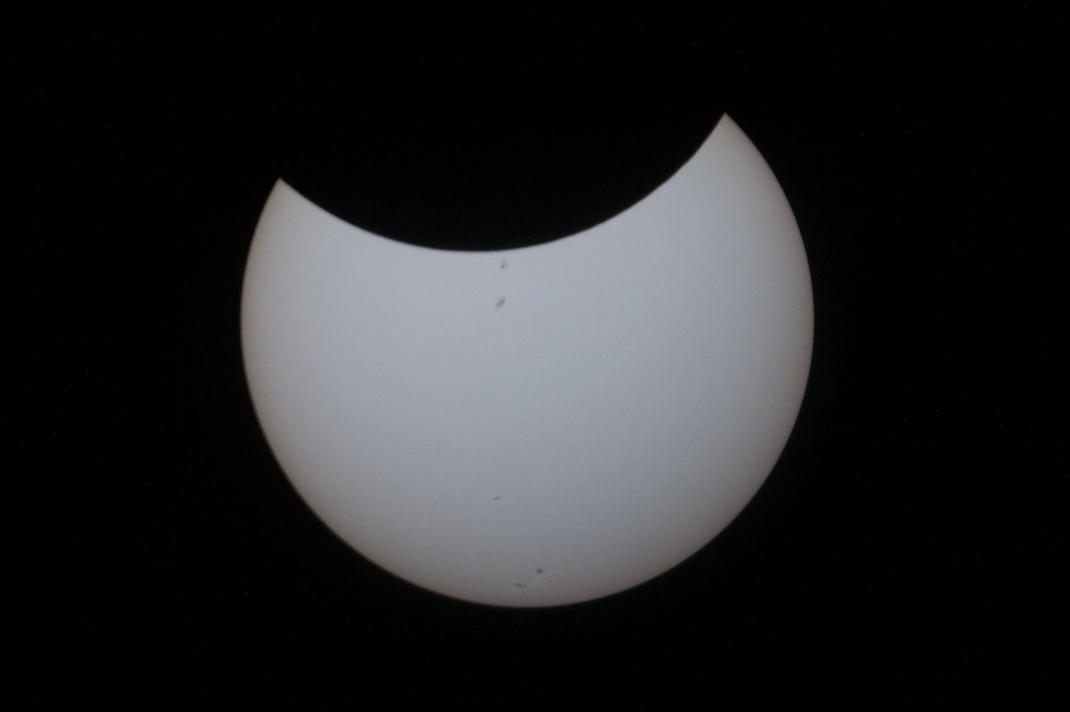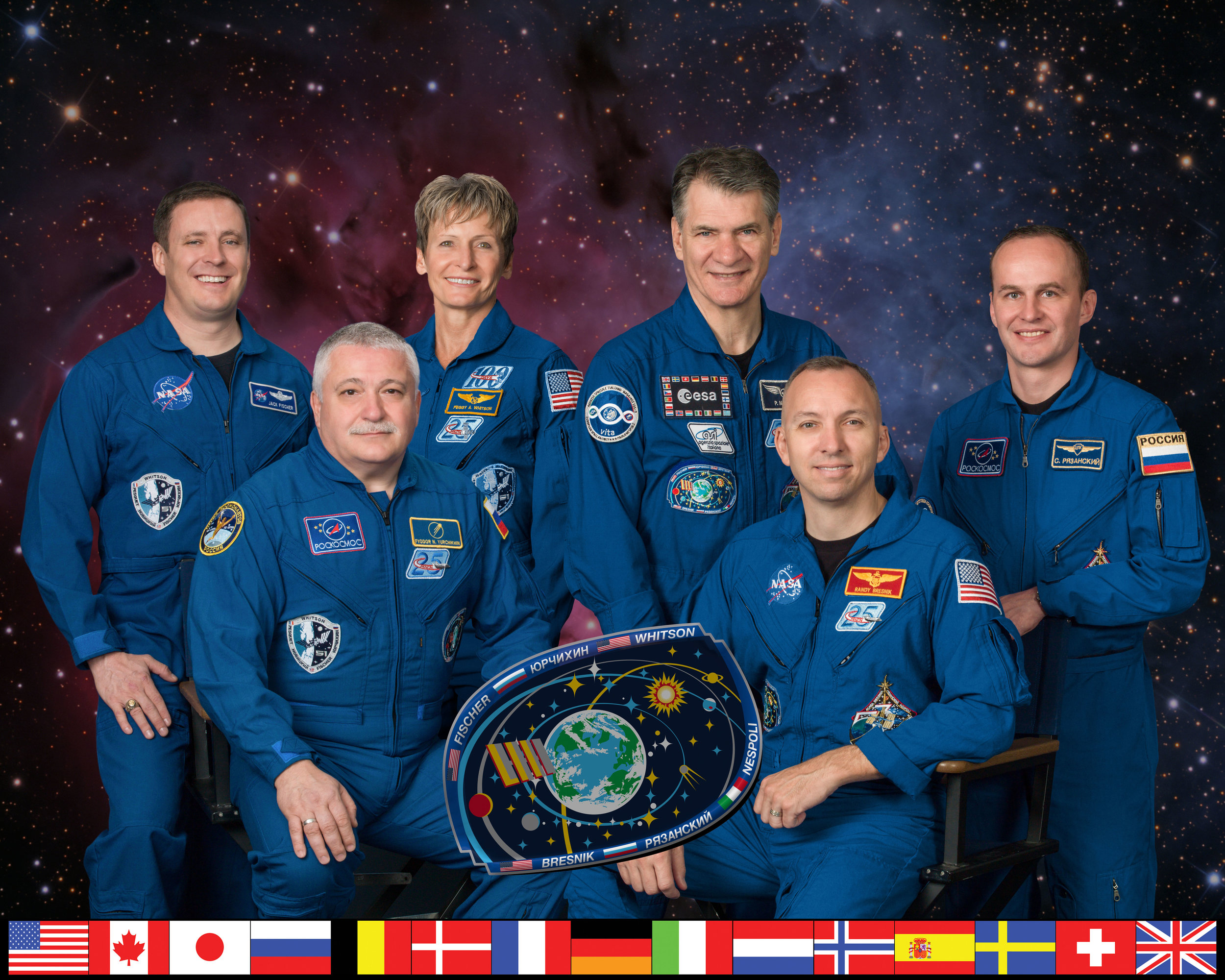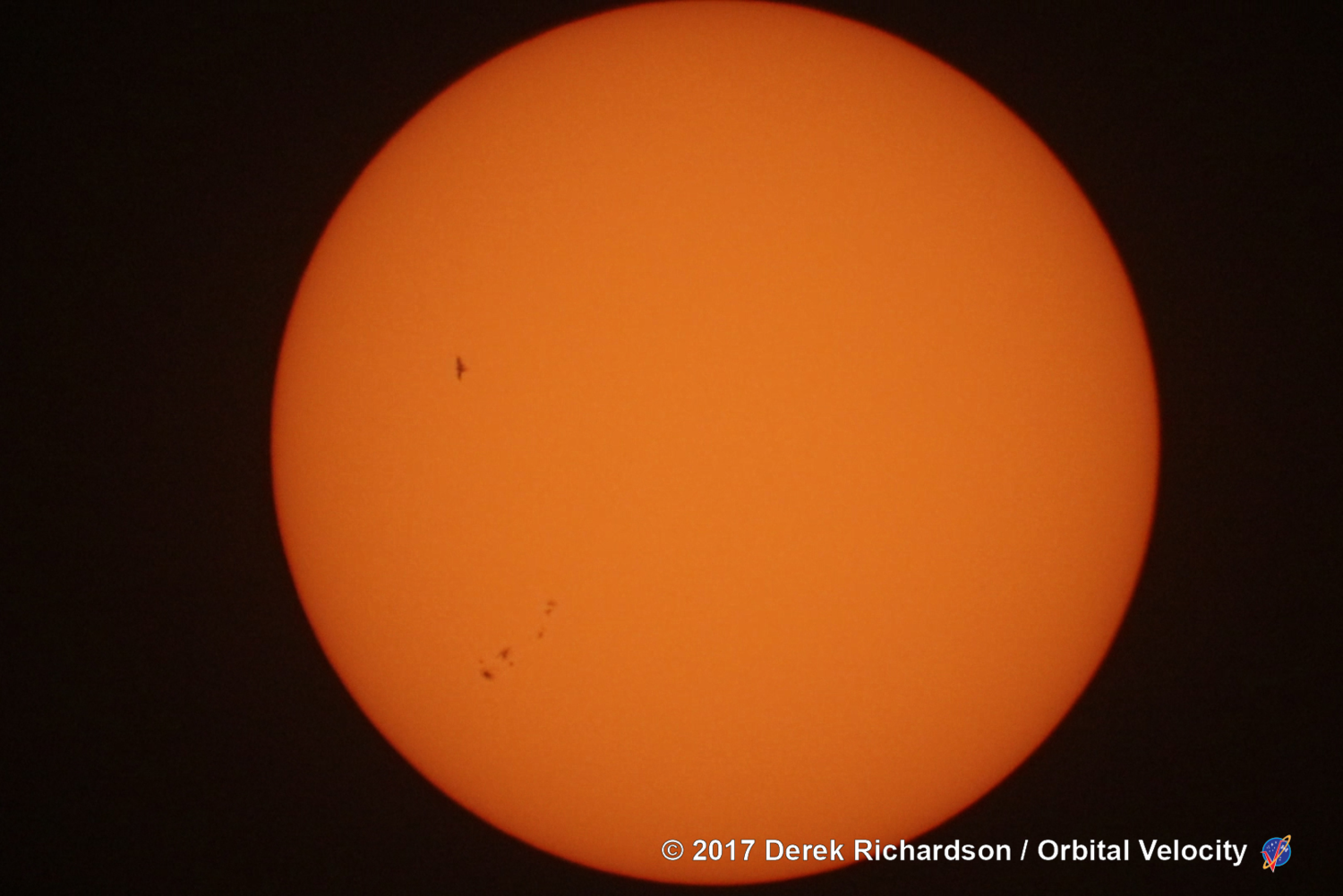Expedition 52
/Began June 2, 2017; transitioned to Expedition 53 on Sept. 2, 2017
First Part
Transferred from Expedition 51
Fyodor Yurchikhin, Roscosmos
| Commander
Jack Fischer, NASA
| Flight Engineer
Peggy Whitson*, NASA
| Flight Engineer
Launched: April 20, 2017, aboard Soyuz MS-04
Landed: Sept. 3, 2017
Second Part
Docked July 28, 2017
Randy Bresnik, NASA
| Flight Engineer
Sergey Ryazansky, Roscosmos
| Flight Engineer
Paolo Nespoli, ESA
| Flight Engineer
Launched: July 28, 2017, aboard Soyuz MS-05
Landed: Dec. 14, 2017
* Whitson was given a three-month extension mid-flight. She flew into space Nov. 17, 2016, aboard Soyuz MS-03 and landed with the Soyuz MS-04 crew on Sept. 3, 2017.
— Statistics —
Max. crew size: 6
Started: June 2, 2017
Ended: Sept. 2, 2017
Duration: 93 days
Orbits of Earth: ~1,500
Launch site: Baikonur Cosmodrome, Kazakhstan
Spacecraft: Soyuz-MS-04, Soyuz MS-05
Experiments conducted: ~150
Spacewalks: 1
Total spacewalk time: 7 hours, 34 minutes
Visiting vehicle arrivals: 3
Visiting vehicle departures: 3
— Mission Summary —
Russian cosmonauts Fyodor Yurchikhin and Sergey Ryazansky; NASA astronauts Jack Fischer Peggy Whitson and Randy Bresnik; and European Space Agency astronaut Paolo Nespoli spent the three-month increment performing studies over more efficient solar arrays, the physics of neutron stars and new drugs that could potentially fight osteoporosis. One spacewalk was performed and three cargo ships supplied the outpost during that time period.
— Major Events —
Expedition 52 begins
At 10:47 UTC June 2, 2017, Soyuz MS-03 undocked, officially beginning Expedition 52. The three leaving were Expedition 51 crew members Oleg Novitskiy of Russia and Thomas Pesquet of the European Space Agency.
Staying behind on the outpost to form the first part of Expedition 52 were Russian cosmonaut Fyodor Yurchikhin and NASA astronauts Jack Fischer and Peggy Whitson. Whitson, who launched in Soyuz MS-03, was granted a three-month extension and would leave the ISS in September 2017 with the crew of Soyuz MS-04.
OA-7 Cygnus departs
Two days after the Soyuz MS-03 crew left, the unpiloted cargo spacecraft OA-7 Cygnus also departed after being berthed to the outpost for nearly 43 days. Named S.S. John Glenn after the late Mercury program astronaut, the vehicle brought to the outpost more than 3,300 kilograms of supplies.
At 13:10 UTC June 4, the spacecraft was unberthed from the Earth-facing port of the Unity module using the 17.6-meter robotic Canadarm2 and moved to a position just below the Destiny module to be released. It then slowly moved away from the outpost to begin a week-long free-flight mission.
That free-flight mission's primary objective was for ground controllers to robotically perform the SAFFIRE-III experiment. The SAFFIRE experiments are the largest flame studies conducted in space. They are designed to better understand flame propagation on various materials in a bid to design safer spacecraft.
For this experiment, a cotton-fiberglass sample, identical to the one for SAFFIRE-I in 2016, was set ablaze. For this run, however, two fans were set at different speeds to measure how airflow can influence flame propagation in zero gravity.
Cygnus was commanded to deorbit and burn up over the Pacific Ocean at 16:37 UTC June 11.
CRS-11 Dragon
Continuing with the rapid-fire arrivals and departures of visiting vehicles, SpaceX launched its CRS-11 Dragon resupply mission from Florida to the ISS on June 3. It spent two days catching up with the outpost before rendezvousing with it to allow for crews to use Canadarm2 to capture the vehicle.


It was then moved to the Earth-facing port of the Harmony module where it stayed for about 27 days. The CRS-11 Dragon capsule pressure vessel was the same one used during the CRS-4 mission in 2014.
The spacecraft carried about 2,700 kilograms of cargo into orbit. After it was unloaded by the Expedition 52 crew, it was reloaded with equipment bound for an Earth return.
The spacecraft had originally been planned to splash down on July 2, but due to a forecast of unacceptable sea conditions at the recovery zone, mission managers decided June 30 to postpone the capsules departure from the station.
Dragon left the outpost at 6:41 UTC July 3. Once it was unberthed, it spent several hours phasing away from the ISS before performing a deorbit burn.
After re-entering Earth’s atmosphere, Dragon splashed down in the Pacific Ocean just off the coast of Baja California. Recovery teams then pulled it out of the water and placed it onto a ship to transport to the Port of Los Angeles several days later.
Progress MS-06 arrival
Next was the arrival of the Progress MS-06 cargo freighter. It launched from Baikonur Cosmodrome in Kazakhstan on June 14 and rendezvoused and docked with the aft port of the Zvezda service module at 11:37 UTC June 16.
Progress MS-06 carried about 1,400 kilograms of pressurized cargo as well as 880 kilograms of fuel for station propulsion, 420 kilograms of water, and 47 kilograms of oxygen for the crew.
It was expected to remain at its current location until early December 2017. before undocking with several metric tons of unneeded equipment and trash.
Soyuz MS-05 brings 3 fresh crew members


After a six-hour, four-orbit trek to rendezvous and dock with the International Space Station, the three-man crew of the Soyuz MS-05 spacecraft joined Expedition 52, increasing the outpost’s population to six people.
Docking took place at 21:54 UTC July 28, 2017, while the spacecraft and station were flying over Germany. Two hours later, at 23:57 UTC, Russian cosmonaut Sergey Ryazansky, European Space Agency astronaut Paolo Nespoli, and NASA astronaut Randy Bresnik entered through the hatch of the Rassvet module where their spacecraft was docked.
The Soyuz group and trio inside the ISS greeted each other with smiles and hugs before moving to the Zvezda service module for a post-docking conference with friends and family members on the ground.
Soyuz MS-05 launched from Baikonur atop a Soyuz-FG rocket at 15:41 UTC. Ryazansky, Nespoli and Bresnik would remain aboard the ISS for about 4.5 months.
CRS-12 Dragon arrival
Another Dragon, CRS-12, visited the ISS on Aug. 16, 2017. It was the last new first-generation Dragon spacecraft to be flown. All subsequent "Dragon 1" flights would be refurbished from previous flights. It was berthed to the Earth-facing port of Harmony, just like all previous Dragon missions before it.
Among the 2,900 kilograms of cargo that CRS-11 brought to the ISS were several external experiments including the Cosmic Ray Energetics and Mass Investigation, or CREAM (sometimes referred to as ISS-CREAM). This instrument, which is designed to look for the origins of cosmic rays, has since been attached to the exposed facility on the Japanese Kibo module.
Inside one of the Dragon capsule’s freezers were small cups of chocolate, vanilla and birthday cake-flavored ice cream. These freezers were reloaded with various research samples before the spacecraft departed the station.
The CRS-12 Dragon would remain attached to the ISS into Expedition 53, unberthing and leaving the ISS on Sept. 16.
Russian EVA-43
Continuing the busy summer 2017 schedule, two Russian cosmonauts ventured outside the outpost on Aug. 17, 2017, to perform Russian EVA-43. The spacewalk lasted more than an hour longer than planned for a total duration of 7 hours, 34 minutes.
Fyodor Yurchikhin, the commander for the six-person Expedition 52 crew, and Flight Engineer Sergey Ryazanskiy depressurized the Pirs module and opened the airlock hatch at 14:36 UTC to perform a variety of tasks ranging from testing a new version of the Russian Orlan spacesuit, deploying five small satellites, installing external experiments, and collecting microbial samples on the hull of the ISS.
During the whole EVA, the new Orlan-MKS, worn by Yurchikhin, suit was being evaluated. It is designed to be easier to use and be more robust. It can be used 20 times over six or seven years supporting spacewalks up to nine hours in duration. Additionally, it has a new thermal control system, suit management computer, and a more durable material in the outer protective layers of the suit, among other things. The latter also makes the suit lighter.
After all activities were finished, the duo made their way back to Pirs. The hatch was closed at 22:10 GMT, officially ending the spacewalk.
2017 total solar eclipse
On Aug. 21, 2017, millions of Americans witnessed the first total solar eclipse to cross North America from the Pacific to Atlantic coasts in 99 years. While much of the country experienced cloudy conditions, the six-person crew of the station were able to see the Moon's umbra from above the weather—in space.


With an orbital re-boost on Aug. 9, 2017, the space station was lined up to be able to cross the path of the eclipse three times. While none of those passed under the umbra, the Moon's full shadow, the outpost did travel into the penumbra, the area of partial shadow. The point of maximum eclipse for the six onboard was 84 percent.
Expedition 52 Flight Engineer and NASA astronaut Randy Bresnik took images of the eclipse while the other crew members, NASA's Peggy Whitson and Jack Fischer, the European Space Agency astronaut Paolo Nespoli, and Russian cosmonauts Fyodor Yurchikhin and Sergey Ryazanskiy, observed and took pictures of the umbra touching the Earth.
While a large chuck of areas in the Midwest and some of the South had cloudy weather or worse, the western states of Oregon, Idaho and Wyoming had nearly perfect skies. It was in the latter state that NASA photographer Bill Ingalls ventured to capture the ISS traveling across the Sun as the moon was partially in front of the Sun as well.
Soyuz MS-04 returns to Earth, ending Expedition 52
Expedition 52 ended when Soyuz MS-04 undocked and returned to Earth. Aboard were Peggy Whitson, Jack Fischer and Fyodor Yurchikhin. They left behind Randy Bresnik, Sergey Ryazansky and Paolo Nespoli to form the first half of the Expedition 53 crew.
Their journey back to Earth began at 18:41 UTC Sept. 2, 2017, when the hatches between the spacecraft and space station were closed. Several hours later, at 21:58 UTC, Soyuz MS-04 undocked from the ISS. When the spacecraft was about 20 meters from the outpost, its thrusters fired to push the spacecraft away faster. Then, some 90 seconds later, a second departure burn was performed to push the vehicle out of the station’s 200-meter Keep-Out Sphere.


The two vehicles continued to separate over the next several hours until they were several miles apart and the Soyuz’ orbit was in line with the landing zone. Then the spacecraft pointed its main engine in the direction of travel to perform a 4-minute, 39-second deorbit burn. This occurred at about 00:29 UTC Sept. 3 to slow the vehicle down by about 128 meters per second.
Several minutes before making contact with Earth’s upper atmosphere, the three modules of the Soyuz—the Orbital Module, the Descent Module, and the Service Module—separated. Only the Descent Module with the crew is designed to survive re-entry.
The Soyuz began skirting the atmosphere at nearly 8 kilometers per second just before 01:00 UTC while at an altitude of about 100 kilometers.
Once the atmosphere slowed the capsule down enough, a series of parachute deployments occurred starting with the release of pilot chutes to pull the drogue chute out. This occurred at an altitude of just over 10 kilometers while traveling some 200 meters per second.
Peggy Whitson, left, Fyodor Yurchikhin, center, and Jack Fischer sit in chairs after being removed from their Soyuz MS-04 spacecraft. Credit: NASA/Bill Ingalls
The drogue chute slowed the capsule to about 80 meters per second before the single main parachute was deployed. Its 1,000-square-meter surface area slowed the capsule to a reasonable 6.5 meters per second.
Throughout the next 10 minutes of descent, the spacecraft and crew began preparing for touchdown. First, the heat shield was jettisoned to reveal the Soft Landing engines. Next, the cabin pressure was equalized with the outside pressure. Finally, the Kazbek crew seats were moved slightly upward relative to the horizon to help absorb the shock of landing.
About one second before touchdown, the Soft Landing engines ignited in a momentary burst to cushion the final meter of the crew’s journey home.
The Soyuz was pulled onto its side by its parachutes, a normal occurrence. Minutes after landing, search and recovery teams in helicopters and all-terrain vehicles rushed to the capsule to begin extracting the crew. First out was Yurchikhin, as he was in the center seat. Next was Fischer and then Whitson.





























Blazing through Earth’s atmosphere and coming to a parachute assisted touchdown in Kazakhstan, three International Space Station crew members returned home in their Soyuz MS-04 capsule. The landing took place at 9:21 p.m. EDT Sept. 2 (7:21 a.m. local time / 01:21 GMT Sept. 3), 2017.